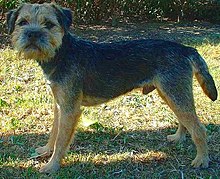Border Terrier
The Border Terrier is a small, rough-coated breed of dog of the terrier group. Originally bred as fox and vermin hunters, Border Terriers share ancestry with Dandie Dinmont Terriers, Patterdale terriers[citation needed] and Bedlington Terriers.
Though the breed is much older, the Border Terrier was officially recognized by The Kennel Club in Great Britain in 1920, and by the American Kennel Club (AKC) in 1930. The border terrier was bred to have long enough legs to keep up with the horses and other foxhounds, which traveled with them, and small enough bodies to crawl in the burrows of foxes and chase them out so the hunters had a blank shot. The foxhounds that traveled with them were not small enough to do the Border terrier's job.
In 2006, the Border Terrier ranked 81st in number of registrations by the AKC,while it ranked 10th in the United Kingdom.
In 2008, the Border Terrier ranked 8th in number of registrations by the UK Kennel Club.
Appearance
Identifiable by their otter-shaped heads, Border Terriers have a broad skull and short (although many are fairly long), strong muzzle with a scissors bite. The V-shaped ears are on the sides of the head and fall towards the cheeks. Common coat colors are grizzle-and-tan, blue-and-tan, red, or wheaten. Whiskers are few and short. The tail is naturally moderately short, thick at the base and tapering.
Narrow-bodied and well-proportioned, males stand 13 to 16 in (33 to 41 cm) at the shoulder, and weigh 13 to 15.5 lb (5.9 to 7.0 kg); females 11 to 14 in (28 to 36 cm) and 11.5 to 14 pounds (5.2 to 6.4 kg).
The Border Terrier has a double coat consisting of a short, dense, soft undercoat and harsh, wiry weather and dirt resistant, close-lying outer coat with no curl or wave. This coat usually requires hand-stripping twice a year to remove dead hair. It then takes about eight weeks for the top coat to come back in. For some dogs, weekly brushing will suffice. Most Border Terriers are seen groomed with short hair but longer hair can sometimes be preferred.
Temperament
Though sometimes stubborn and strong willed, border terriers are, on the whole very even tempered, and are friendly and rarely aggressive. They are very good with children, but may chase cats and any other small pets.
Borders do well in task-oriented activities and have a surprising ability to jump high and run fast given the size of their legs. The breed has excelled in agility training, but they are quicker to learn jumps and see-saws than weaving poles. They take training for tasks very well, but appear less trainable if being taught mere tricks. The border in recent years has been bred to harbor a more subtle character so are more adaptable to apartment living if properly exercised.
They are intelligent and eager to please, but they retain the capacity for independent thinking and initiative that were bred into them for working rats and fox underground. Their love of people and even temperament make them fine therapy dogs, especially for children and the elderly, and they are occasionally used to aid the blind or deaf. From a young age they should be trained on command.
Borders can adapt to different environments and situations well, and are able to deal with temporary change well. They will get along well with cats that they have been raised with, but may chase other cats and small animals such as mice, birds, rabbits, squirrels, rats, and guinea pigs.
Borders love to sit and watch what is going on. Walks with Borders will often involve them sitting and lying in the grass to observe the environment around them.
History
The Border Terrier originates in, and takes its name from the Scottish borders. Their original purpose was to bolt foxes which had gone to ground. They were also used to kill rodents, but they have been used to hunt otters and badgers too.
The first Kennel Club Border Terrier ever registered was The Moss Trooper, a dog sired by Jacob Robson's Chip in 1912 and registered in the Kennel Club's Any Other Variety listing in 1913. The Border Terrier was rejected for formal Kennel Club recognition in 1914, but won its slot in 1920, with the first standard being written by Jacob Robson and John Dodd. Jasper Dodd was made first President of the Club.
 | ||||
| Country of origin | UK - Scotland / England | |||
|---|---|---|---|---|
| ||||
| ||||





No comments:
Post a Comment